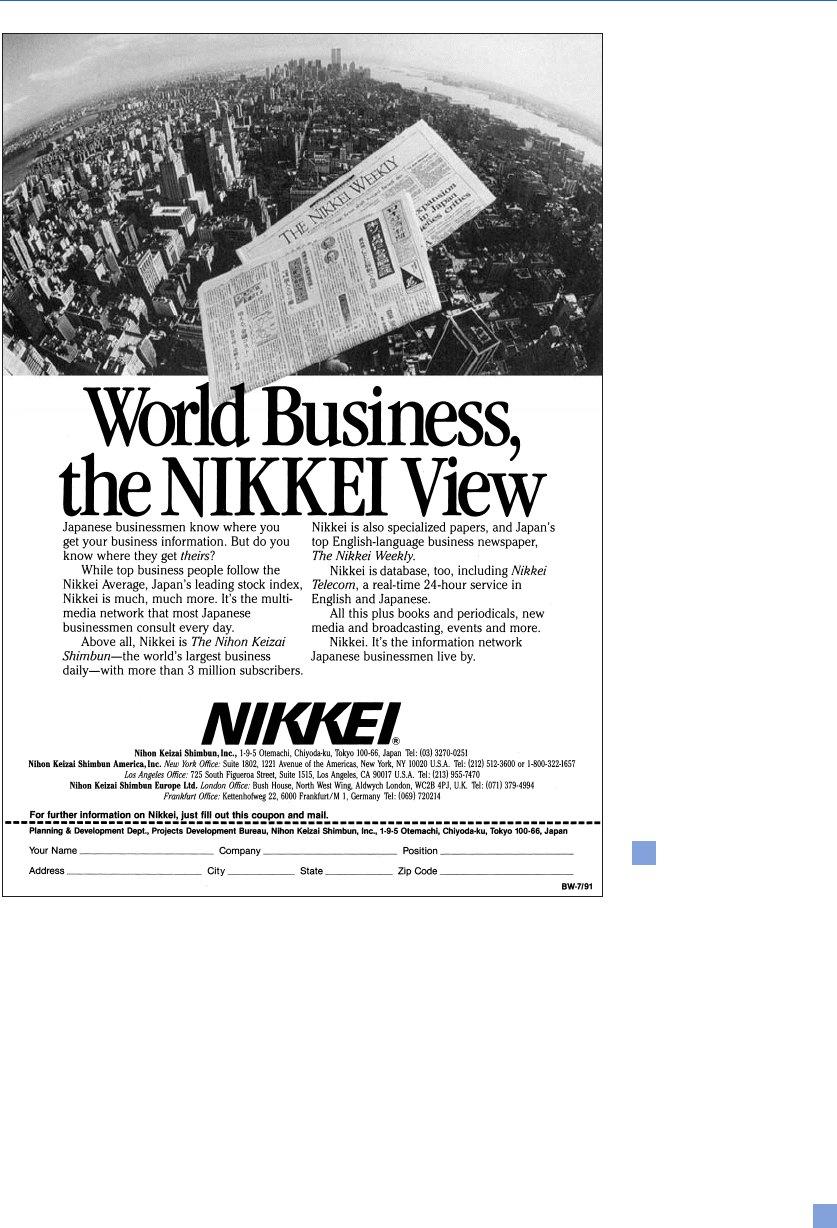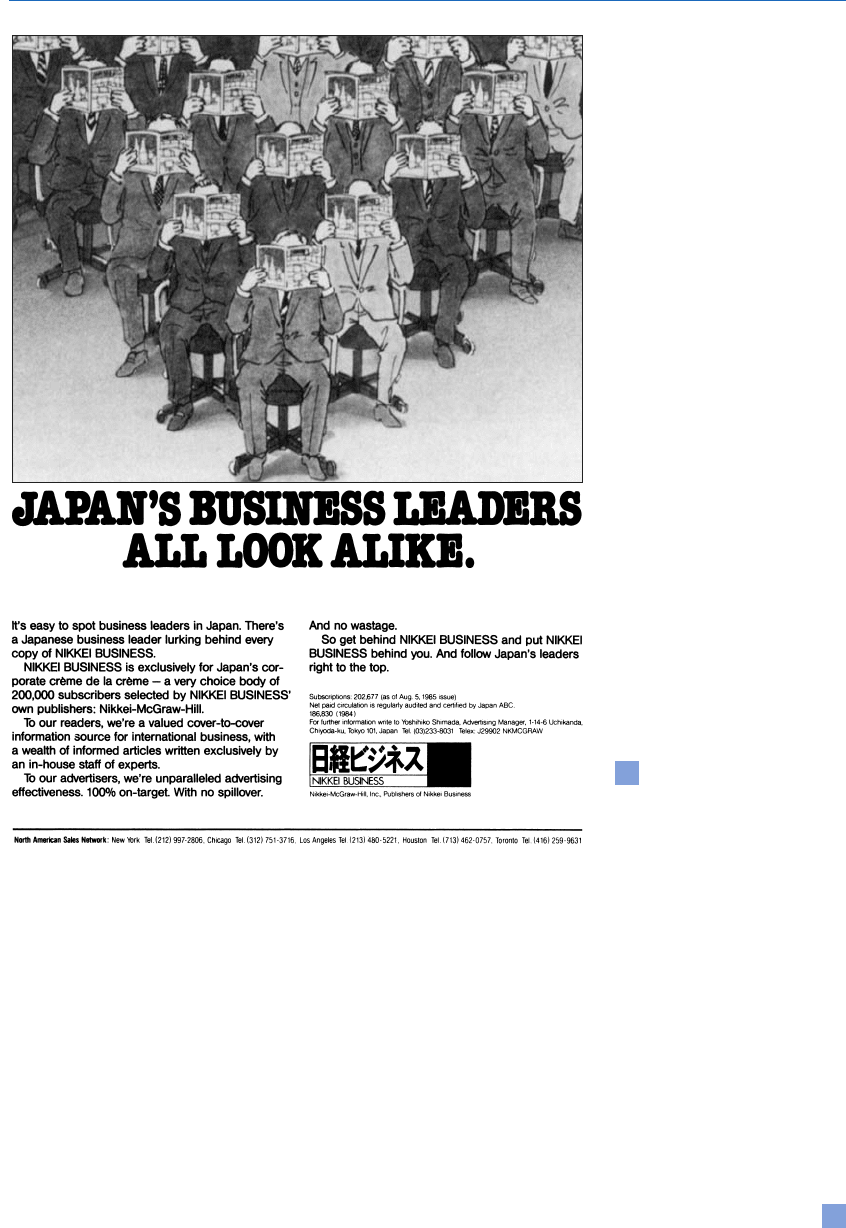Onkvisit S., Shaw J. International Marketing: Analysis and Strategy
Подождите немного. Документ загружается.


In the USA, large cities can rarely support more
than two dailies. In other countries, a city may
have numerous newspapers dividing the readership
market. Lebanon, with a population of 1.5 million,
has some 200 daily and weekly newspapers, with an
average circulation per paper of only 3500.
Newspapers in communist countries are con-
trolled by the government and are thus used
for propaganda purposes. China’s newspapers, for
example, tend to carry news items that the
government deems to express some moral and
social value.
Believing that sensational news attracts reader-
ship, most non-US newspapers in the free world are
set up in a sensational news format. It is the rule
rather than the exception for these newspapers to
concentrate on murders, robberies, scandals, and
rapes. Even the United Kingdom, where its citizens
are known for their reserved manner, is not exempt
from this practice. World news and nonscandalous
political news often take a back seat to the more
sensational news. As a result, non-US newspapers
look more like such weekly US tabloids as the
National Enquirer and Star. A newspaper that con-
centrates on news of substance and quality (i.e.,
unsensational news) must pay for this in terms of
low readership.
Many countries have English-language newspa-
pers in addition to the local-language newspapers.
The English-language newspapers are patterned
more like the traditional American paper, with an
emphasis on world, government, and business
news. This vehicle would be appropriate for an
advertiser to reach government and business
leaders, educated readers, upper-class people, and
those with affluence and influence. The aim of the
Asian Wall Street Journal is to supply economic infor-
mation in English to influential businesspersons,
politicians, top government officials, and intellectu-
als. It was not designed to be a newspaper for mass
readers.
Many countries have nationally distributed news-
papers, as shown in Figure 15.1. However, it is dif-
ficult to find a true national newspaper because
almost every newspaper tries to be somewhat local
in nature. Even in the USA, before USA Today, the
closest thing to a national newspaper was perhaps
the New York Times, with the Washington Post in second
place. Clearly, it is even more difficult to have an
international newspaper. Those papers distributed
internationally include the International Herald
Tribune and such financial newspapers as the Wall
Street Journal (with the Asian Wall Street Journal
for Asian countries) and the United Kingdom’s
Financial Times. As might be expected, these news-
papers are not available everywhere, and the circu-
lation is low. Financial Times, a century-old daily
covering British business, international business,
and economic and political news, has a worldwide
circulation of about 230,000, with only 6000 sold
in the USA and Canada. Still, Financial Times offers
US advertisers access to upscale readers in Europe
and other parts of the world.
American advertisers are accustomed to having
separate editorial sections in American newspapers
and are often frustrated by foreign papers. A
twenty-page newspaper may still have sections for
sports, entertainment, fashion, business, and
science, but each section may comprise only one
page.Thus it becomes difficult for an advertiser to
match the product to the proper section or environ-
ment (e.g., tire and automotive products in the
sports section) in a local newspaper.
Furthermore, with so many newspapers dividing
a small market, it is expensive to reach the entire
market.There are some 380 and 800 newspapers in
Turkey and Brazil, respectively. With advertise-
ments in just one paper, the reach would be quite
inadequate. Advertising in several papers, on the
other hand, is also impractical. It is fortunate for
advertisers that people often read or subscribe to
two or more dailies and often share newspapers.
Despite a small circulation, readership may still be
high. Usually, the pass-along rate in foreign markets
is much higher than that in the USA, but reliable
estimates of circulation of overseas newspapers are
difficult to obtain.The figure provided by the news-
paper publisher may be highly inflated, and there
is no meaningful way, at least for advertisers, to
measure or audit the circulation figures.
446
ADVERTISING

Magazines
Nowhere in the world are there so many and varied
types of consumer magazines as there are in the
USA. Because US magazines segment the reading
market in every conceivable manner, there are mag-
azines for the masses as well as for the few and
selected. This makes is possible for advertisers to
direct their campaigns to obtain reach (the total
number of unduplicated individuals exposed to a
particular media vehicle at least once during a spec-
ified time period) or frequency (the intensity or
the number of times within a specified period that
a prospect is exposed to the message) or both.
Foreign magazines are generally not highly devel-
oped in terms of a particular audience. They do
not segment their readers as narrowly as do US
magazines, and they do not have the same degree of
1111
2
3
4
5
6
7
8
9
10111
1
2
3
4
5
6
7
8
9
20111
1
2
3
4
5
6
7
8
9
30
1
2
3
4
5
6
7
8
9
40
41
42
43
44
45111
447
ADVERTISING
Figure 15.1 Japan’s
top English-language
business newspaper

accurate information about reader characteristics.
In Brazil, there are very few magazines, and people
read all three or four of them.This results in dupli-
cation, which can be a waste of promotional effort
unless frequency is the objective.
Marketers of international products have the
option of using international magazines that publish
regional editions (e.g., Time, Business Week, Newsweek,
and Life). In the case of Reader’s Digest and several
other popular magazines, local-language editions
are distributed (see Marketing Strategy 15.1).
Allen-Edmonds, a shoe company, was able to
increase its foreign sales by advertising its shoes in
the international editions of such magazines. For
technical and industrial products, magazines can
be quite effective. Technical-business publications
tend to be international in their coverage. These
publications range from individual industries (e.g.,
construction, beverages, textiles) to worldwide
industrial magazines covering many industries. A
trade magazine about China, for example, is a suit-
able vehicle for all types of industrial products of
interest to the Chinese government. In Europe, the
number of business publications is seven times as
high as that in the USA.There are more than 1000
technical and trade journals in Scandinavia. Canada,
in contrast, usually has only one trade magazine for
each market segment, making it easier to cover the
entire Canadian market.
Local (i.e., national) business magazines are a
good vehicle to reach well-defined target audiences.
Nikkei Business is one such magazine in Japan (see
Figure 15.2).
Unlike the US market, which has an organization
such as the ABC (Audit Bureau of Circulations) to
audit the circulation figures for most magazines, the
circulation figures of overseas magazines are some-
what unreliable. Furthermore, overseas magazines
448
ADVERTISING
Reader’s Digest
, publishing in forty-eight countries
and nineteen languages, reaches some 100 million
readers.The company, appreciating both universal and
local appeals, exports a business strategy rather than
a culture. “We understand that people the world over
hunger for information that is relevant to their lives,
in their . . . language, and form their own perspective.
We produce magazines, books, and other products
that meet that need. For all intents and purposes, each
edition of
Reader’s Digest
is a local product, with
as much as 30% of the editorial content researched
and written by local editors. It is the only American
magazine with international editions that routinely
imports overseas content for US edition.”
For decades, men’s magazines have been around
in Japan and Australia. The region is now embracing
a new experience: international titles with Asian edi-
tions.
Esquire
,
GQ
, and
FHM
have started up Asian
editions that target young, active,urban men with high
disposable income. South Korea is the biggest market
in Asia for such products. Why do South Korean men
read these international magazines? A good reason
has to do with the fact that these magazines have
adapted their editorial concepts and contents to fit the
various readerships. The Asian editions, not merely
publishing in local languages, cover local trends and
personalities. A magazine is a cultural product. As
such, it must reflect a local culture.
Thailand has 648 magazine titles, both local and
international. Women’s magazines, the most competi-
tive segment, account for 60 percent of the market. In
2003 alone, five more Thai-language versions of for-
eign titles were announced. Among them are
Elle Girl
and
Marie Claire
from France and
Her World
from
Singapore. A Thai version of
Madame Figaro
from
France was just recently introduced. The Thai edition
of
Lisa
(from Germany and sold in nineteen countries)
is the ninth foreign-language title of the magazine.
Source:
“Timing Concerns Don’t Deter Launch of Men’s
Magazine,”
Asian Wall Street Journal
, November 15, 2001;
“Five Women’s Magazines to Enter the Fray,”
Bangkok
Post
, September 16, 2003.
MARKETING STRATEGY 15.1 THE MAGAZINE AS A CULTURAL PRODUCT

tend to depend more on news-stand sales than on
subscription sales, making it difficult to calculate
consistent volume or to predict the size of reader-
ship in advance. Because many magazines are unau-
dited, either by choice or by lack of an audit bureau,
it is not sensible to exclude unaudited publications
from the media schedule. Even when publications
are audited, the information given may not be
adequate. The English ABC provides minimum
information,whereas the German IVW audit is very
thorough.
Direct mail
Confusion usually arises when such terms as direct
mail, direct advertising, direct marketing, and mail
order are discussed. It is important to understand
that direct marketing is a broad term that encom-
passes the other related terms. According to the
Direct Marketing Association (DMA), direct mar-
keting is “the total of activities by which products
and services are offered to market segments in
one or more media for informational purposes or to
1111
2
3
4
5
6
7
8
9
10111
1
2
3
4
5
6
7
8
9
20111
1
2
3
4
5
6
7
8
9
30
1
2
3
4
5
6
7
8
9
40
41
42
43
44
45111
449
ADVERTISING
Figure 15.2 A national
business magazine
Source:
Reprinted with permission
of Nikkei-McGraw Hill, Inc.

solicit a direct response from a present or prospec-
tive customer or contributor by mail, telephone, or
personal visit.”This is a more than 1-billion business
in the USA. As a system, direct marketing has
two distinct components: (1) promotion, and (2)
ordering/delivery (see Figure 15.3).
Direct marketers can promote their products
through all advertising media. They can solicit
orders by making announcements on television or
in magazines (usually with coupons or order forms).
Television home shopping is a form of direct mar-
keting. Some cable TV channels (e.g., the Home
Shopping Network in the USA and the Canadian
Home Shopping Network) are designed specifically
for this purpose. In any case, local regulations must
be followed. In France, advertisers cannot show
direct sales telephone numbers on screen. Viewers
must call the number on screen to obtain a second
number for placing orders.
12
Frequently, marketers rely on direct advertis-
ing in media created for that purpose.These media
consist of direct mailings and all forms of print
advertisements distributed directly to prospects
through a variety of methods (i.e.,advertising mate-
rials distributed door-to-door, on the street, or
inside the store or those placed inside shopping bags
and on auto windshields). Direct mail is thus only
one kind of direct advertising medium, which is
in turn a part of general advertising media or the
promotional methods of direct marketing. Of
course, the use of direct mail is not limited only to
direct marketing.
With regard to ordering, buyers can place orders
by telephone (often with a toll-free number),
through a personal visit, or by mail. An order that
is sent in by mail and fulfilled by mail delivery is
called a mail order. Thus mail order is not a
medium; rather it is only one of several means that
may be used to place and handle orders. An order-
ing method consists of one of the two components
of the direct marketing system.
For this discussion, direct mail and direct mar-
keting are considered together. There are several
reasons for doing so. Direct mail generally accounts
for a major portion of direct marketing advertising
expenditures. In addition, many reports on direct
marketing campaigns do not provide a detailed
breakdown of the advertising dollar accounted for
by media other than direct mail.
Direct mail is largely undeveloped in many coun-
tries.This is especially true where labor is cheap and
abundant and where it is just as easy to use a sales-
person to make sales calls. Furthermore, for coun-
tries with high illiteracy, this medium is not suitable
for promoting consumer products.
Without doubt, the USA is the most developed
market for the advertising medium of direct mail.
Foreign marketers as well as American marketers
have a wide selection of buyer lists that permit them
to contact the intended target audience with
minimum waste.
European marketers lag far behind the USA in
exploiting the medium of direct mail.There are also
more restrictions on collection of personal data (see
It’s the Law 15.1). In Germany, mail cannot be sent
to those who have requested that their names be
removed from mailing lists. If an addressee has a
label on one’s mailbox refusing direct mail, delivery
cannot be made. Furthermore, although personal
data may include year of birth, date of birth is not
allowed.
13
US practices in using direct mail require some
modification when taken abroad.There is difficulty
450
ADVERTISING
Direct marketer Prospects
Ordering methods
Mail order
Telephone
Personal visit
Promotion methods
Advertising media
Direct advertising
Direct mail
Figure 15.3 Direct marketing

in making a direct transposure of a US mailing piece
without change into a European mailing kit due to
various weight rules and other unique regulations.
Population direct mail lists are another serious
problem since foreign list owners do not trust
renters and brokers. List generation and manage-
ment is still primitive abroad.American list owners
enhance their lists with such information as buyer’s
frequency, recency, and dollar value,but direct mar-
keters used to those practices can become frustrated
with list brokers in Europe (except in Germany)
because basic selection criteria are not even pro-
vided. In addition, privacy laws are more restrictive
abroad than in the USA. For example, Germany
allows only two unique selection criteria per order
when renting a list.
US companies using direct mail to contact cus-
tomers abroad may find remailing useful and eco-
nomical. There are three basic ways to move a
marketer’s promotional material from the USA.
First, the ISAL (International Surface Airlift) system
was designed by the US Postal Service to use a com-
bination of air and surface transportation. This is
the least expensive way of moving materials for
bulk mailers and publishers.After being received at
ISAL’s acceptance points, the material is airlifted to
selected distribution points around the world where
it merges with other surface-mail pieces. Second,
1111
2
3
4
5
6
7
8
9
10111
1
2
3
4
5
6
7
8
9
20111
1
2
3
4
5
6
7
8
9
30
1
2
3
4
5
6
7
8
9
40
41
42
43
44
45111
451
ADVERTISING
Because there is no pan-European law, each country’s
law must be analyzed. In France, it is illegal to collect
data having to do – directly or indirectly – with mem-
bership of trade unions. In Germany, as a consequence
of the Nazis’ use of personal information to identify
enemies, the country’s data-protection laws may be
the most restrictive in the European Union. Germany
prohibits virtually all activities regarding collecting,
storing, and processing personal data. In general, all
storage, communication, and erasure of personal data
are not allowed unless expressly permitted by the
data-protection act. Data processing is prohibited
unless a person has given his or her written consent.
In England, the Direct Marketing Association Code of
Practice requires list owners to warrant that “the
data have been fairly and lawfully obtained and all
private individuals whose data are included have been
given an opportunity to object to the use of their data
by persons other than the list owner and that the data
of those who have objected have either been deleted
from or so marked in the list.”
Unlike the USA which has relied on the industry’s
self-regulatory approach, the European Union has
adopted the government-led approach. European
privacy laws, based on Europe’s history and legal
traditions, are comprehensive and applicable to all
industries. After all, protection of information privacy
is regarded as a fundamental human right in Europe.
The European Directive on Data Protection,
taking effect in 1998, requires the European Commis-
sion to determine the adequacy of data protection in
third countries and to prohibit personal data flows to
countries without adequate privacy regimes. Any
organizations wanting to receive personally identifi-
able information from the European Union must
provide adequate privacy protection. Electronic com-
merce certainly needs data transfers. Multinational
corporations and their affiliates routinely exchange a
huge amount of information. The information ranges
from personnel phone directories to more sensitive
information such as personnel records and credit-card
bills. As a result, Microsoft and hundreds of American
companies have agreed to comply with the European
Union’s Safe Harbor framework. Information may be
collected for “specified, explicit and legitimate pur-
poses, and to be held only if it is relevant, accurate
and up to date.”
Sources:
James A. Reiman, “Understanding Variations in
European Market Laws,”
DM News
, July 25,1994, 8–9; Jeff
Rohlmeier and William Yue, “The Safe Harbor Privacy
Framework,”
Export America
(January 2001): 21–4;
“Europe’s Tough Privacy Rules Spill Over to US,”
San José
Mercury News
, August 30, 2002.
IT’S THE LAW 15.1 KEEP IT PRIVATE

mailers who do not want to bother with ISAL’s
requirements can pay a surcharge to ISAL consol-
idators, which are private companies that will sort,
bag, and transport the material to an ISAL gateway
city. Finally, remailers are private distribution ser-
vices that provide a turnkey system and negotiate
private rates with airline cargo divisions.
14
Outdoor
Outdoor advertising includes posters, billboards,
painted bulletins, roadside and store signs, and elec-
tric spectaculars (large illuminated electric signs
with special lighting and animated effects). Given
the huge impact and impressiveness of size and
color, outdoor advertising serves well as reminder
promotion for well-known products.
Outdoor advertising is frequently used overseas
because of the low cost of labor in painting and
erecting such displays. In addition, this is considered
a free medium, because an advertiser can simplify
place its posters on any available wall, bus-stop
shelter, tree, or fence without paying for it. The
practice also encourages one advertiser to replace
other advertisers’ posters with one of its own.
Unlike most media, outdoor advertising is one
medium in which the USA seems to lag behind
other countries in terms of per-capita advertising
expenditures and sophistication.This is an advanced
and dominant medium in Europe and Canada.
Outdoor advertising is also very important in coun-
tries without commercial TV (e.g., Belgium). In
Saudi Arabia, outdoor and transit posters account
for more than a quarter of all media spending, about
ten times the US percentage.
Outdoor advertising does not have to be unin-
teresting. One advertiser changes its outdoor illus-
tration and message frequently – with the model
removing an item of clothing each time the poster
board is changed.Another advertiser made it appear
that the billboard was gradually being eaten away by
termites.
New technologies have added such designoptions
as backlighting, projection, Day-Glo paints, three-
dimensionals, extensions, reflective disks,bows,and
cutouts. Fiber optics may eventually replace neon
because fiber optics are much more energy efficient
and weigh less than neon glass tubing. Some adver-
tisers have turned to video billboards that can show
a twenty-second commercial repeatedly.
When using outdoor advertising, certain rules
should be followed. Illustrations should be large,
and words should be kept to a minimum. A rule of
thumb is to say “what must be said” and not “what
can be said.” Simple, contrasting colors should be
used: white on black or red seems to work well.The
right typeface is crucial; certain typefaces are diffi-
cult to read. Having all letters in capitals can be
equally as difficult and should be avoided.
Internet
One recent medium that has gained worldwide
attention is the Internet. Unlike other media, the
Internet is global in nature, creating both worldwide
opportunities and problems. It is unknown whether
the law governing an Internet promotion should be
the law of the upload site or that of the download
site. Although all the other media allow marketers
to a certain extent to restrict delivery of their mes-
sages, the Internet is an all-or-nothing proposition.
Thus, it is so easy to violate many domestic laws.
Also, given its international nature, the Internet
requires global planning, and the cultural dimension
must be considered.A successful website is the one
that has been carefully planned, taking into account
the various languages and cultures.
One significant development is that new soft-
ware has allowed a multinational marketer to make
users’ locations dictate a particular website to
which users will be exposed. For example, those
in Western Europe trying to access the website of
Coca-Cola may end up with a European site rather
than the one seen by their American counterparts.
In addition, owing to technological improvements
coupled with marketing goals, the Internet has
become a more selective medium.Yahoo has created
regional portals. Many international marketers
such as Coca-Cola have added local websites in local
languages.
452
ADVERTISING

The Coca-Cola Company has stated that, in spite
of the core brand being well recognized all over the
world, it is still “very much a local operation,
meeting the demands of local tastes and cultures in
nearly 200 countries.” Visitors to its website are
encouraged to select the country of interest.At one
time,Atlanta dictated everything, and the local divi-
sions were not allowed to set up their own websites
and instead had to show only the corporate home
page. Coca-Cola’s Belgian website now reflects the
more international approach, and the trilingual
(Dutch, French, and English) site draws more than
three million hits per month.
15
While Internet usage is a worldwide phenome-
non, it does not mean that a marketer should
standardize its Internet strategies on a worldwide
basis. A study of advanced Internet users from
twenty countries reveals differences in beliefs,
attitudes, perceptions, and Internet buying behavior
based on user experience and home country or
region. Such differences remain even after control-
ling for social, cultural, and macroeconomic
variables.
16
In the case that an international marketer wants
to offer only one website (unlike Coca-Cola’s strat-
egy), its website must be designed to accommodate
global users.While graphics are appealing,they slow
things down, especially when users in most coun-
tries have slower connections. Thus by limiting
graphics and other high-bandwidth features, the site
is faster and universally appealing. By adopting a
global perspective for the website, a company can
enhance its international opportunities. Global
functionality and language concerns should be
addressed.
17
While shopping and Internet use are global
behavior, shopping manner and the determinants of
the Internet sites’ attractiveness may be culture-
bound.To determine the crucial characteristics of a
website, one study investigated the shopping tasks
of 299 respondents from twelve countries. In
general, site quality, trust, and positive affect toward
it are related to both purchase intentions and site
visitors’ loyalty. Because the impact of these factors
varies across regions and product categories, a
website probably should be tailored for each region
as well as each product category.
18
By 2005, 70 percent of the estimated one billion
Internet users will be non-English speakers. The
localization of websites, particularly transaction-
based websites,requires native language capabilities.
Research indicates that Web users are three times
more likely to make purchases over the Internet if a
site is in their native language. Some languages,
particularly character-based ones such as Chinese or
Japanese, have double-byte requirements, necessi-
tating added memory, cost, and disk space.
19
It is not a simple task to build a multilingual e-
commerce site.
20
Other than the language that must
be overhauled, a site must be able to handle differ-
ent currencies, characters, and measurements.
Some languages have words that must be read from
right to left. Certain US Net icons such as shopping
carts are alien in some countries.Therefore, a global
website has to be culturally sensitive.
Screen (cinema)
In virtually all countries, the cinema is a favorite
activity for a social gathering. People are avid movie-
goers because of the limited television broadcasting
and because of people’s natural desire to go out to
a place of social gathering. Cinemas (or theaters, as
they are called in many parts of the world) are clas-
sified as first-class or second-class and sometimes
even third-class, depending on how soon new films
are shown there. Theaters usually operate on a
reserved-seat basis, with advance reserve bookings
being highly encouraged.
Similar to outdoor advertising, the cinema is a
very popular advertising medium outside of the
USA. Cinemas sell commercial time to agencies or
advertisers. The usual practice is for a theater to
begin its program with a showing of slides of adver-
tised products, and this slide show is followed by
commercials.The theater may then proceed to show
newsreels and documentaries that may contain
paid news items such as a store opening.Then, just
before the showing of the main feature, there are
short promotional films or teaser trailers of coming
1111
2
3
4
5
6
7
8
9
10111
1
2
3
4
5
6
7
8
9
20111
1
2
3
4
5
6
7
8
9
30
1
2
3
4
5
6
7
8
9
40
41
42
43
44
45111
453
ADVERTISING

attractions. An intermission can present another
opportunity for advertising.
Cinema advertising has several advantages. It has
the impact of outdoor advertising without the draw-
back of being stationary. It has sight and sound like
television but with better quality. Furthermore,
cinema advertising has a true captive audience. A
disadvantage is that some moviegoers may resent
having to watch commercials, but such resentment
is likely to be a minor problem, since moviegoers
are usually in a positive and receptive mood. The
more serious problem is that patrons, knowing that
there will be some commercials shown first, take
their time in showing up and may be wandering
into and around the theater until the main feature
begins.
Directories
Directories are books that provide listings of
people, professions, and institutions. The yellow-
page telephone directories, with a listing of various
types of companies, are a prime example. Directo-
ries may be sold or given away free of charge. Since
the telephone is not widely available in many areas
and the information is not accurate, this medium
has been underused outside of the USA. In some
countries, governments and private entities publish
trade directories of local exporters and their
advertisements.
The popularity of cellular or mobile phones pre-
sents another unique problem. In Japan, the number
of mobile phones has now exceeded the number of
fixed telephones. Given the fact that cellular phone
owners may switch the telephone services from one
company to another, their telephone numbers are
somewhat temporary. In addition, there is no com-
pilation of cellular phone numbers so as to publish
a directory.
Rural media
In marketing to developing countries, marketers
must understand the use of rural media. Mobile
units, for example, may be sent to areas lacking
access to mass media. Such vehicles can play
recorded music and advertising messages over
amplifiers or loudspeakers attached to the vehicles’
rooftops. A marketer can also attract an audience
by arranging for some type of festival advertising
held at a temple or school. A free outdoor movie
may be shown during the festival while advertising
is broadcast through loudspeakers to the captive
audience. In a way, such rural media are not very
different from the traveling “medicine” shows of the
American past.
Stadiums
Stadium advertising is also appropriate, especially in
soccer stadiums, because soccer (i.e.,football) is the
most popular and passionate sport in the world.
Signs can be displayed on stadium walls, and the
advertising rules for outdoor advertising should be
applied. The objective of this advertising is not so
much to communicate with those in a basketball or
football stadium but rather to communicate with
TV viewers. For nonstop games such as soccer and
hockey, a broadcaster can show the entire game
while including logos or brief advertising messages
on the edges of the screen – at the top, bottom,side,
or all around, with the game being shown in the
middle part of the screen.
Cigarette marketers are major sponsors of sports
and cultural events (e.g., billiards, horse-racing,
rugby, and concerts) in England because these
events receive extensive TV coverage. In effect, the
prominent display of names and logos allows com-
panies to associate their brands with glamour,
health, vitality, and success.
Other media
There are several other advertising media that are
traditional and common in developing countries and
elsewhere. Some of these media are advertising
specialties, a variety of inexpensive items (e.g.,
pens, calendars, letter openers) carrying the adver-
tiser’s name, address, and a short sales message. In
spite of the cost, such items are relatively durable.
454
ADVERTISING

Because of their attractive appearance and low pro-
duction cost, Ajinomoto’s calendar-type products
make an effective display in Japan and other Asian
countries. A charming, attractive young girl (Miss
Ajinomoto) serves as an “eye-catcher” to help adver-
tise products. Ajinomoto provides three-ounce
bottles to restaurants as toothpick holders or salt
and pepper containers. In addition to using the trav-
eling cinema, a popular form of entertainment,
Ajinomoto also uses the traveling cooking school,
which combines the expertise of a cook and a nutri-
tionist, to provide instruction and education to
many institutions such as schools. Moreover, the
company uses “exhibitions,” or public service adver-
tising, to promote total company image and techni-
cal expertise, such as with the anti-cancer medicine
Lentinan and the sugarless sweetener Aspartame.
21
Media mix
There is no one single advertising medium that is
suitable for all countries and products. The media
mix has to vary from one target market to another.
The basis principles of media selection apply in
all markets. In general, an advertising medium
should be selective and cost-effective in reaching a
large number of the intended audience. It should
deliver the kind of reach, frequency, and impact
desired, assuming that there are no particular legal
restrictions.
Tokyo Toyopet provides a good illustration of
how advertising media are selected to promote cars
– in this case, Toyota cars. Newspapers and maga-
zines, due to their national circulation in Japan, are
unsuitable because this division of Toyota only con-
centrates on the Tokyo market. TV time is not
readily available and much too expensive. As a
result, radio advertising is the clear-cut choice.
STANDARDIZED INTERNATIONAL
ADVERTISING
Standardized international advertising is the prac-
tice of advertising the same product in the same way
everywhere in the world. The controversy of the
standardization of global advertising centers on the
appropriateness of the variation (or the lack of it)
within advertising content from country to country.
The technique has generated a heated and lively
debate for four decades and has been both praised
and condemned – passionately.
Doing research is difficult in this area due to
the ambiguous definition of standardization itself.
Strictly speaking, a standardized advertisement is an
advertisement that is used internationally with vir-
tually no change in its theme, copy, or illustration
(other than translation). More recently, a new breed
of advocates of standardization has claimed that an
advertisement with changes in its copy or illustra-
tion (e.g., a foreign model used in an overseas
version) is still a standardized advertisement as long
as the same theme is maintained. This new and
broadened definition can cloud the issue even more
with the added element of subjectivity. Because
standardization is a matter of degree rather than an
all-or-nothing phenomenon, a more precise defini-
tion of standardized advertising, conceptually and
operationally, would go a long way toward solving
the confusion created by contradictory claims.
Dewar’s advertising is a good example of how
difficult it is to state with certainty whether or not
a certain advertisement is a standardized advertise-
ment. After twenty years, the highly regarded US
“Profiles” campaign for Dewar’s Scotch whisky was
tailored to markets around the world.The format is
the same in every country: it provides biographical
information, hobbies, and philosophies to portray
the successful lifestyle of an entrepreneurial
“life-achiever” who also happens to be a typical
and famous Dewar’s drinker (see Figure 15.4).
Previously, Dewar’s overseas advertising used trans-
lations of American advertisements, but research
revealed that the use of local personalities would
communicate a stronger message. The localized
profile advertisements used in Spain featured pro-
files of a Spanish author and a 29-year-old Spanish
flight instructor and former hang-gliding champion.
The Australian campaign gave Dewar’s profiles of
a 33-year-old Melbourne entrepreneur, a jewelry
designer, and a photojournalist. In Thailand, the
1111
2
3
4
5
6
7
8
9
10111
1
2
3
4
5
6
7
8
9
20111
1
2
3
4
5
6
7
8
9
30
1
2
3
4
5
6
7
8
9
40
41
42
43
44
45111
455
ADVERTISING
